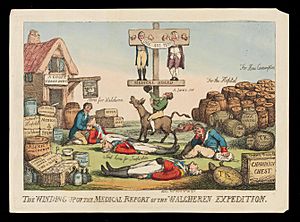Thomas Keate facts for kids
Thomas Keate (born 1745, died 1821) was an important English surgeon. He became a Fellow of the Royal Society in 1794. The Royal Society is a famous group for scientists.
Contents
Early Life and Training
Thomas Keate was born in 1745. His father, William Keate, lived in Wells, Somerset, and was a graduate of Oxford University. Some records say his father was also a pharmacist (an apothecary) in Wells and even became the mayor of the town. Thomas had an older brother, William Keate, who was a reverend.
Thomas Keate started his medical training as a student at St George's Hospital in London. Later, he worked as an assistant to John Gunning, who was a surgeon at the same hospital. In 1778, Keate was appointed as a surgeon for the 1st Foot Guards, which was an army regiment.

Working with Royalty
Thomas Keate became the surgeon to Prince George, who later became King George IV. He worked for the Prince from 1783 to 1800. Keate was one of the Prince's favorite doctors and was even introduced to other members of the royal family. He also served as surgeon to Queen Charlotte of Mecklenburg-Strelitz from 1791 to 1803. His important work for the royal family was mentioned when he was nominated to join the Royal Society in 1793.
In 1790, Keate was appointed as the surgeon to Chelsea Hospital, a place that cared for retired soldiers. This job came with a good salary. In 1792, there was an opening for a surgeon at St George's Hospital. There was a strong competition between Keate and Everard Home, but Keate was chosen for the position.
Keate became an examiner at the College of Surgeons in 1800. He was also chosen as the Master of the College in 1802, 1809, and 1818. In 1803, he represented the College when he watched a demonstration by Giovanni Aldini in London. Aldini showed how electricity could affect a body. As a surgeon, Keate was the first to successfully tie off the subclavian artery to treat an aneurysm, which is a dangerous bulge in a blood vessel.
Army Surgeon General
When the famous surgeon John Hunter died in 1793, John Gunning became the Surgeon-General to the Army. Thomas Keate took over Gunning's previous role as Inspector of Regimental Infirmaries. In October of that year, Keate inspected the Savoy Hospital and found that it had only six beds in a very noisy area because of prisoners nearby.
After Gunning passed away in 1798, Keate took on both roles, becoming the Surgeon-General to the Army and the Inspector of Regimental Infirmaries.

Keate and Lucas Pepys faced criticism for the lack of medical supplies and care during the Walcheren Campaign in 1809. Keate had personally attended to some of the injured soldiers who were brought up the River Thames by boat. As a result of these problems, the Army Medical Board, which included Keate, Pepys, and Francis Knight, was replaced in 1810. A new board was formed to improve medical services for the army.
Later Life and Work
In 1813, Thomas Keate resigned from his position at St George's Hospital. He was known for sometimes being late and not always being neat in his hospital duties.
Keate disagreed with the claims made by surgeon Sir William Adams. Adams said he had a very effective cure for a type of eye infection called ophthalmia. In 1817, Adams even set up a special treatment center at Chelsea Hospital for this condition. It affected soldiers who had served in the Egyptian campaign and is now known as a form of trachoma. In 1818, Keate, along with Benjamin Moseley and William North, published research that questioned how well Adams's treatment worked. Despite this, Adams continued his work, opening a new Ophthalmia Hospital in London in 1818.
Thomas Keate passed away at Chelsea Hospital on July 5, 1821. He was 76 years old.
Writings
Thomas Keate wrote a book about surgery called Cases of Hydrocele and Hernia in 1788. He also wrote Observations on the Fifth Report of the Commissioners of Medical Enquiry in 1808. This second book was his response to a report that had criticized some parts of his work as an administrator.
Family Life
In 1784, Thomas Keate married Emma Browne. She was the daughter of Lyde Browne.

